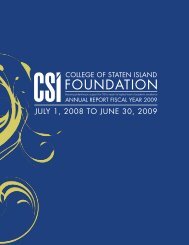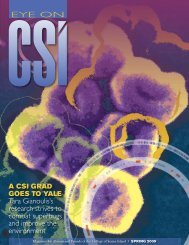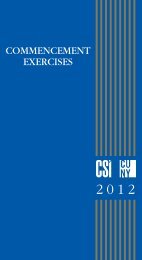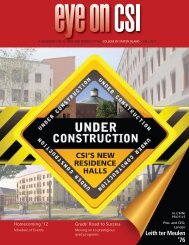csi undergraduate conference on research, scholarship ... - CSI Today
csi undergraduate conference on research, scholarship ... - CSI Today
csi undergraduate conference on research, scholarship ... - CSI Today
You also want an ePaper? Increase the reach of your titles
YUMPU automatically turns print PDFs into web optimized ePapers that Google loves.
Research Poster Presentati<strong>on</strong>sP O S T E R 3 1Cl<strong>on</strong>ing and Expressi<strong>on</strong> of theTransmembrane Domain ofNKG2D Natural Killer CellReceptorVadim DushkinFaculty Mentor: Dr. Sebastien PogetDepartment of ChemistryNatural Killer Cells (NK cells) are a crucialcomp<strong>on</strong>ent of the innate immune system. Thesecytotoxic lymphocytes play a major role in theapoptosis of virally infected and tumor cells. Whatmakes these immune system cells unique is theirability to perform these functi<strong>on</strong>s without previousexposure to the abnormal cells and without thedependence <strong>on</strong> MHC molecules of infected cells. Astressed or an infected cell's ability to express theMHC-I molecule can be inhibited resulting in theinability of the cell to be recognized by the body'simmune system. However, the cell does expressstress-induced molecules which are displayed <strong>on</strong>the surface. The NK cell c<strong>on</strong>tains receptors <strong>on</strong> itssurface which detect the presence of the stressinducedsurface molecule and the absence of theMHC-I molecule. This combinati<strong>on</strong>, if detected bythe NK cell results in the activati<strong>on</strong> of the NK celland the release of perforin and granzyme moleculesinto the infected cell leading to the cell's eventualdeath. The activati<strong>on</strong> of the NK cell depends <strong>on</strong> thecell\'s triggering receptors. The structure of thesereceptors includes transmembrane domains whichc<strong>on</strong>nect the extracellular ligand binding domainswith the intracellular domain that triggers theactivati<strong>on</strong> signaling cascade through aphosphorylati<strong>on</strong> event. A major triggering receptorof the NK cells is NKG2D. While the extracellularpart of the receptor has been structurallycharacterized, the c<strong>on</strong>formati<strong>on</strong>al changes of thetransmembrane domain before and duringactivati<strong>on</strong> are of interest. In this presentati<strong>on</strong>, wesummarize our attempts to generate proteinsamples of the transmembrane domain regi<strong>on</strong> ofNKG2D for structural studies. Overlapping primerswere utilized to c<strong>on</strong>struct a synthetic gene, thesynthesized gene was cl<strong>on</strong>ed into a maltose bindingprotein fusi<strong>on</strong> vector and expressi<strong>on</strong> of the genewas tested in several E. coli strains. Purificati<strong>on</strong> ofthe fusi<strong>on</strong> protein was attempted.P O S T E R 3 2Cognitive Development InToddlers: Exploring IndividualDifferences in Locomotor AbilityMelinda Andrade, ReginaFeldman,Yekaterina RikhterFaculty Mentor: Professor Naomi AldrichDepartment of PsychologyToddlerhood is a critical time in motordevelopment for children as coordinati<strong>on</strong> is not yetfully developed. During this period, motordevelopment is not limited to low-level perceptualmotorskills, such as grasping, crawling, or visualexplorati<strong>on</strong>. Research shows that toddlers use“means-ends” problem solving when performinglocomotor tasks (Berger & Adolph, 2003). Forinstance, Berger and Adolph showed that cognitiveunderstanding is essential in toddler’s use of toolsduring a difficult locomotor task: children will use ahandrail to help them successfully cross a narrowbridge. The present study, as a replicati<strong>on</strong> of thestudy by Berger and Adolph, examines children’sdecisi<strong>on</strong>s to use a handrail when given narrowbridges. Twenty-two toddler boys (16-m<strong>on</strong>th-olds)participated in two trials each. Trials varied bybridge width (from 12 to 48cm) and by handrailpresence. Using archival video data from theoriginal study, we examined: children’s attempts tocross the bridge, number of steps taken in crossingthe bridge, amount of time to cross the bridge,whether or not they used the handrail, and latency(i.e., amount of time the child waited beforeattempting to cross the bridge). Resultsdem<strong>on</strong>strated that toddlers attempted to cross thebridge more often when they had a wider bridge tocross. Additi<strong>on</strong>ally, toddlers utilized the handrailmore often when c<strong>on</strong>fr<strong>on</strong>ted with a narrow bridge,and changed their body positi<strong>on</strong>s when presentedwith a narrow bridge. Infants who used morecognitive abilities, were more likely to accomplishthe goal of crossing the bridge successfully.Toddlers also showed c<strong>on</strong>ceptualizati<strong>on</strong> of tool usewhile walking over wide and narrow bridges beingthat they explored the handrail when they felt itwas needed. Overall, the findings of the currentstudy suggest that exploratory behaviors and gaitmodificati<strong>on</strong>s combine with cognitive thinking inorder to help toddlers successfully achieve alocomotor goal.41
















